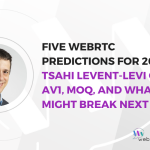
On the December 10, 2025 episode of WebRTC Live, host Arin Sime welcomed Chris Allen, CEO of Red5, to explore how LLMs can be integrated into real-time video workflows to detect critical conditions within live streams for use cases like traffic monitoring and crowd congestion to forest fire

Each month, our CEO Arin Sime sits down with long-time WebRTC industry authority Tsahi Levent‑Levi of BlogGeek.me to discuss the latest real-time communications trends and challenges. In their November 2025 session, Arin asked Tsahi five pointed questions and gave him 90 seconds per answer, pushing for clear

The choice between conversation-based and turn-based Voice AI agent patterns is a strategic business decision, not just a technical detail. Beyond what your agent will say, you must decide how it will run. This architectural choice defines how your voicebot will scale, what it will cost to

On the November 19 episode of WebRTC Live, we attempted to settle the debate on “MOQ vs. WebRTC” once and for all. Since Cloudflare has been expanding its offerings in 2025, with both WebRTC- and MOQ-related product announcements, we invited a few members of their team for a






